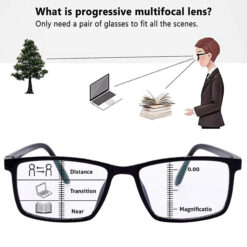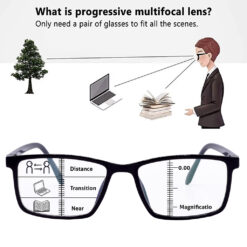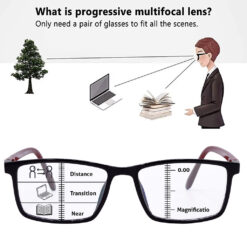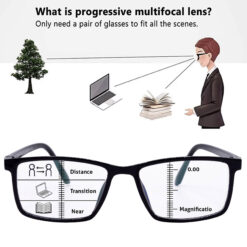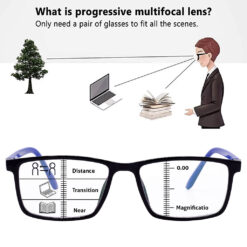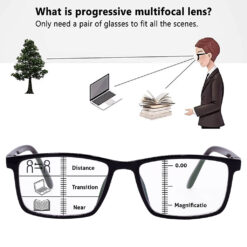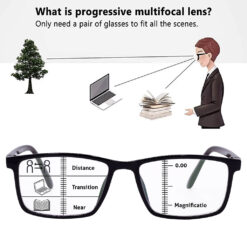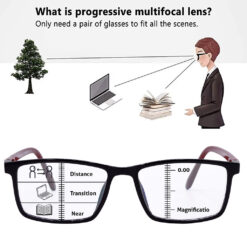Progressive Reading Glasses
Progressive Reading Glasses
Progressive Reading Glasses
Progressive Reading Glasses
Progressive Reading Glasses
Progressive Reading Glasses
Progressive Reading Glasses
Progressive Reading Glasses
Progressive Reading Glasses
Progressive Reading Glasses
Progressive Reading Glasses
Progressive Reading Glasses
Progressive Reading Glasses
Progressive Reading Glasses
Progressive Reading Glasses
Buy Reading Glasses with Progressive Lenses Online
Progressive glasses help you see clearly at every distance with one pair of lenses, making everyday life easier without switching between readers and distance glasses. Progressive lenses combine distance, intermediate, and near vision in a smooth, line‑free design, so tasks like driving, computer work, and reading feel natural with less eye strain. If you’re new to progressives, this guide explains what progressive lenses mean, how to choose the best lens for eyes, what progressive lenses cost, and how to buy the best progressive glasses online confidently at opticalindia.com.
You’ll get crisp vision from far to near with a single pair, plus options like blue light protection for screens and lightweight materials for all‑day comfort. Not sure where to start? Use the selection checklist, compare multifocal lenses vs varifocal glasses, and see 2025–2026 trends to find your perfect match today.
Why choose progressive glasses for everyday life?
Progressive glasses give seamless vision at all distances with no visible bifocal lines. Think of them like a gentle ramp from far to near: the top handles distance, the middle is for screens and everyday tasks, and the bottom is for reading. This smooth transition reduces image jump, so your eyes don’t get shocked moving from far objects to your phone. If you’ve been juggling separate reading glasses, progressive reading glasses simplify everything into one clean, stylish pair.
A simple analogy: switching from bifocals to progressive lenses is like moving from stairs to a ramp—you still go from one level to another, but it’s smoother and easier on your body (and your eyes). For most people over 40 facing presbyopia, multifocal progressive glasses offer the most natural, practical solution.
What are progressive lenses and how do they work?
Progressive lenses are multifocal lenses with three vision zones in one lens: distance (top), intermediate (middle), and near (bottom). There are no visible lines—just a gradual power change. This design lets the eyes shift focus naturally, so you can glance up to drive, look straight for your laptop, and drop your eyes to read a menu.
In technical terms, progressive lenses blend increasing add power from top to bottom, using modern free‑form surfacing to optimize clarity. In simple terms, you get all distances in one lens with a natural, adaptable layout. That’s why many people call them varifocal glasses or multifocal glasses—different names, same smart idea.
Who should wear progressive glasses?
Progressive glasses are ideal for anyone who needs help with both distance and near vision—usually due to presbyopia starting in the 40s. They’re great if you:
-
Want one pair for reading, computer, and distance.
-
Don’t like the visible line in bifocals.
-
Use screens often and need a clear intermediate zone.
-
Prefer a modern, clean lens look with flexible viewing.
If you have a complex prescription or are sensitive to lens distortions, premium progressive lenses with wider corridors can make adaptation easier.
Progressive lenses meaning: simple definition you can trust
Progressive lenses meaning: lenses that provide multiple focal powers in a single, line‑free lens so you can see far, intermediate, and near without switching glasses. If you’ve ever wondered “progressive lens kya hota hai?”, it’s the same: ek hi lens mein door, beech, aur nazdeek ke liye power ka smooth transition, bina koi line ke.
Benefits of progressive lenses vs bifocals or two pairs
Progressive lens benefits stack up for everyday comfort:
-
One pair for everything: distance, computer, reading.
-
No visible line: modern, youthful look.
-
Smooth transition: less image jump, fewer headaches.
-
Customizable: wider near zone for reading, or wider intermediate for office work.
-
Add blue‑cut options: reduce digital eye strain on screens.
If you’ve tried juggling two pairs, progressive glasses save time, reduce hassle, and look cleaner in photos and face‑to‑face meetings.
Are progressive glasses worth it?
Yes—progressive glasses are worth it for anyone who needs multifocal vision and wants convenience plus a clean look. The cost is higher than single‑vision lenses, but you’re effectively replacing two or three pairs with one tailored solution. With correct fitting, a suitable corridor length, and a few days of adaptation, most users report sharper, more natural vision across daily tasks. In short, they pay for themselves in comfort and simplicity.
Types of progressive lenses: which is best for your eyes?
Different progressive lens designs serve different needs:
-
Standard progressives: Balanced for daily use with moderate zones.
-
Premium free‑form progressives: Wider clear areas, less distortion, customized to your prescription and frame.
-
Office/computer progressives: Wider intermediate and near for desk work (not meant for long‑distance driving).
-
Short‑corridor progressives: Designed for smaller frames; faster transition from intermediate to near.
-
Blue‑cut progressive lenses: Reduce blue light, useful for heavy screen time.
-
Photochromic progressive lenses: Darken in sunlight, clear indoors; great for outdoor‑to‑indoor shifts.
-
High‑index progressive lenses: Thinner and lighter for higher prescriptions.
As an analogy, think of each type like a different shoe: all are for walking, but some are best for running (office work), some for hiking (daily wear), and some are lighter or more stylish (high‑index, photochromic).
Progressive lens advantages and disadvantages
Here’s the balanced view:
-
Advantages:
-
Natural multi‑distance vision in one pair.
-
No lines; modern look.
-
Custom options for screens, reading, or driving.
-
Fewer pairs to manage.
-
-
Disadvantages:
-
Slight peripheral blur in lower‑tier designs.
-
Short adaptation period (usually days to a week).
-
Higher price than single‑vision lenses.
-
If you’re sensitive to distortion, choose a premium design with a wider corridor and ensure precise fitting measurements.
How to choose the best progressive glasses online
The best progressive glasses online match your daily routine, frame size, and budget. Start with your prescription and pupillary distance (PD), then decide your priorities: wide reading area, comfortable computer vision, or thinnest possible lens. At opticalindia.com, you can select lens packages by use case (work, reading, outdoors) and add blue‑cut or photochromic upgrades. A well‑fitted frame plus accurate PD and segment height makes all the difference.
A quick rule: if you spend most of the day on screens, pick a design with a generous intermediate zone and blue light progressive glasses to cut eye strain.
Progressive lens price and what affects the cost
Progressive lenses price varies by design, material, coatings, and customization. Standard designs are more affordable, while premium free‑form lenses with wider clear zones cost more. Add‑ons like blue‑cut, anti‑glare, scratch‑resistant, photochromic, and high‑index materials also impact progressive lenses cost. Think of it like phone storage: the base model works, but extra features make your experience smoother and last longer.
If budget matters, start with an affordable progressive glasses package and add the one upgrade that matters most (often anti‑glare or blue‑cut for office work).
Buying checklist: what to confirm before checkout
This selection checklist keeps things simple:
-
Current prescription with add power (ADD) for near vision.
-
Accurate PD (pupillary distance) and, if possible, segment height.
-
Frame size fits your face and allows enough lens height (usually 28mm+).
-
Choose lens type: standard, premium, office/computer, photochromic, high‑index.
-
Must‑have coatings: anti‑glare, scratch‑resistant, UV protection; add blue‑cut if you’re on screens.
-
Lifestyle match: reading heavy, driving heavy, or mixed use.
-
Return, remake, and warranty policy for peace of mind.
How to pick frames for progressive lenses
Choose frames with enough vertical height, stable bridge fit, and proper alignment:
-
Lens height: Aim for a lens depth of at least 28–30mm for comfortable zones.
-
Shape: Avoid extremely shallow or narrow rectangles if you read a lot.
-
Fit: A snug bridge and balanced temples keep the optical zones aligned.
-
Material: Lightweight acetate or titanium improves comfort for all‑day wear.
-
Style tip: Rounded squares or soft rectangles usually balance all zones well.
Picture it like placing text on a poster: you need enough vertical space to fit large, readable content without cramping the layout.
Which progressive lens is best for your eyes?
The best progressive lens depends on your daily tasks:
-
Best for office work: office/computer or premium design with a wider intermediate.
-
Best for reading: premium or short‑corridor with a larger near zone.
-
Best for driving: premium lenses with stable distance vision and anti‑glare.
-
Best for heavy screens: blue‑cut progressive lens with broad intermediate.
-
Best for high prescriptions: high‑index progressive lens to keep things thin and light.
If unsure, choose a balanced premium free‑form progressive that covers all three zones well.
Progressive lenses vs varifocal glasses: is there a difference?
Progressive lenses and varifocal glasses are the same concept with different names. Both describe multifocal lenses that provide distance, intermediate, and near correction in a single, line‑free lens. In India and globally, “progressive” is more common in clinical use, while “varifocal” is often used in everyday speech—pick the word that feels natural, the lens is the same.
Progressive reading glasses vs single‑vision readers
Progressive reading glasses include distance and intermediate correction, while single‑vision readers only magnify near tasks. If you only read books and never need distance correction, readers can work. But if you read, look up at a screen, then glance across the room, a progressive lens saves constant on‑off swapping. Many users notice fewer headaches and less neck strain because they don’t crane forward to find focus.
Blue light progressive glasses: do you need them?
Blue light progressive glasses add a blue‑cut coating to reduce high‑energy visible light from screens, which can help with digital eye strain and improve comfort during long work hours. If you spend 4–8 hours on computers or phones, this upgrade is worth it. For night driving, pair blue‑cut with anti‑glare to reduce halos and reflections from headlights.
Progressive lenses care and maintenance tips
Treat your lenses well and they’ll stay clear longer:
-
Rinse with clean water before wiping to remove dust.
-
Use a microfiber cloth—don’t use tissues or shirt hems.
-
Clean with lens spray or mild dish soap; avoid harsh cleaners.
-
Store in a hard case when not wearing.
-
Don’t leave in hot cars; heat can damage coatings.
-
Schedule regular checks if frames loosen or alignment shifts.
A little routine care is like servicing a scooter: quick checkups keep performance smooth and extend life.
How to adapt to progressive glasses faster
Most people adapt in a few days, some in a week:
-
Point your nose where you want to look; move your head slightly, not just your eyes.
-
Use the top area for distance, the middle for screens, and the bottom for reading.
-
Wear them full‑time for the first week; don’t switch back and forth.
-
Choose frames with proper height and get accurate measurements.
-
If discomfort lasts more than 10–14 days, ask for a corridor or fitting check.
Common doubts about multifocal lenses, answered
-
Will I see blur at the sides? A bit, especially in basic designs, but premium lenses reduce this and your brain adapts.
-
Are they hard to use? There’s a short learning curve; most people adjust within days.
-
Can I drive with them? Yes—use the upper zone for distance and ensure anti‑glare for night driving.
-
Will they look like bifocals? No—the lens is line‑free, so they look like regular glasses.
Progressive lenses cost: how to plan your budget
Here’s a simple way to budget:
-
Base lenses: choose standard progressives if cost is key.
-
One must‑have upgrade: anti‑glare or blue‑cut if you’re on screens.
-
Comfort boost: premium free‑form design for wider clear zones.
-
Lifestyle add‑on: photochromic if in sun often, or high‑index if prescription is strong.
This tiered approach helps you get the best value without overspending.
Best place to buy progressive glasses online
The best place to buy progressive glasses online offers clear lens options, accurate measurement support, easy returns, and fast customer help. Opticalindia.com provides progressive lenses, blue‑cut options, and reader‑focused designs, with a smooth checkout and guidance for PD entry. You can choose affordable progressive glasses or upgrade for wider corridors and lighter materials—all from home, with peace of mind.
Best progressive glasses in India: what to look for in 2025–2026
Trend: Expect more personalized free‑form designs, better blue‑cut coatings with minimal color tint, and lighter high‑index materials. Forecast: Office‑optimized progressives will grow as hybrid work continues, and photochromic blue‑cut combos will become popular for screen‑to‑sun users. If you’re shopping in 2025–2026, look for enhanced anti‑glare and scratch‑resistant coatings and short‑corridor options for compact frames without sacrificing clarity.
Progressive lens blue‑cut: who benefits most?
Anyone who works on screens 4+ hours daily benefits from blue‑cut progressive lenses, especially if headaches or eye fatigue show up after work. Students, designers, coders, and office professionals often report more comfortable vision through the day. Pair this with regular breaks and good lighting for the best results.
Progressive glasses clear on top: how to use zones properly
Use the top of the lens for distance tasks like driving or walking outdoors; that’s where the clearest distance zone lives. Look straight through the middle for computer screens and dashboards, and drop your eyes to the bottom for reading. If you catch yourself tilting your head too much, recheck frame fit—small adjustments can unlock comfort.
Progressive lens buy online: step‑by‑step
-
Select your frame and ensure enough lens height.
-
Enter prescription details, including ADD and PD.
-
Choose lens type (standard, premium, office), then coatings (blue‑cut, anti‑glare).
-
Confirm shipping and warranty/return options.
-
Wear full‑time for the first week to adapt quickly.
Progressive lens advantages and disadvantages at a glance
-
Advantages: all‑in‑one convenience, line‑free design, customizable clarity.
-
Disadvantages: higher cost than single‑vision, short adaptation, potential side blur in basic models.
Pick according to lifestyle and comfort expectations; premium designs reduce most downsides.
Safety, warranty, and eco‑friendly notes
Look for lenses with UV protection, impact‑resistant materials like polycarbonate, and durable coatings to prevent scratches. Warranty support on lenses and coatings offers extra confidence. Many modern labs reduce water waste and use greener packaging; when possible, choose eco‑friendly cleaning sprays and reusable microfiber cloths to cut single‑use waste.
FAQ
What are progressive lenses?
Progressive lenses are multifocal lenses that combine distance, intermediate, and near vision in one line‑free lens for seamless viewing. They replace the need to switch between separate reading and distance glasses and look like regular lenses without visible segments.
Are progressive glasses worth it?
Yes, they’re worth it for most people who need both near and distance correction because they provide convenience, a modern look, and natural transitions between tasks. With a short adaptation period, progressives usually become the most comfortable everyday solution.
How much do progressive lenses cost?
Progressive lenses cost depends on design (standard vs premium), materials (regular vs high‑index), and coatings (anti‑glare, blue‑cut, photochromic). Start with a base package and add the one upgrade that matters most to your day, like blue‑cut for screens.
How long does it take to adapt to progressive lenses?
Most people adapt in a few days to a week by wearing them full‑time at first and using the correct zones for distance, screens, and reading. If discomfort persists past 10–14 days, a fitting check can help fine‑tune the corridor and measurements.
Can I use progressive lenses for computer work?
Yes, progressives include an intermediate zone for screens, and office/computer‑optimized designs offer a wider area for desk work. Add blue‑cut and anti‑glare coatings to reduce eye strain and reflections during long hours.
Conclusion
Progressive glasses deliver seamless vision for distance, computer, and reading in one clean, line‑free lens, making daily life simpler and more comfortable. By choosing the right frame height, accurate measurements, and a lens design matched to your routine, you’ll enjoy sharper focus with fewer swaps and less strain. Whether you want affordable progressive glasses or premium free‑form clarity with blue‑cut protection, opticalindia.com makes it easy to buy progressive glasses online with confidence and support.

